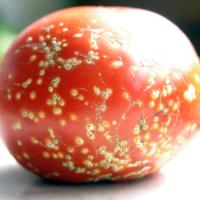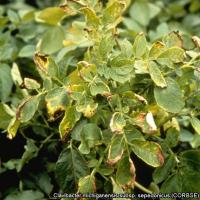Bacterial Canker, Clavibacter michiganensis of Potatoes and Tomatoes
Clavibacter michiganensis subsp. michiganensis
Disease Cycle.
The causal agent of Ring Rot of Potato does not overwinter in the soil. The bacteria survives inside infected tubers or as dried slime on machinery or containers. For instance, if a knife cuts into an infected tuber, the next 20 tubers that the knife cuts have a high risk of becoming infected. The bacteria enters the host through wounds and invades the xylem where it multiplies via binary fission. If colonization is successful, the bacteria may plug the xylem vessels. In advanced stages of infection, the bacteria will move out of the vessels and break down the surrounding parenchyma tissue before moving into new vessels. The bacteria may also invade the roots and cause them to deteriorate.
C. sepidonicus spreads by contaminated soil, surfaces, infected seed, wash waters, infected potato waste, etc. It can survive on warehouse walls, boxes, bags etc. On machinery in dry conditions, it can survive at least a month - sometimes in the form of dried bacterial ooze. It is also able to overwinter in soil in association with plant debris. C. sepidonicus will only survive in the soil as long as the host tissue in which it resides persisits and resists decomposition by saphrophtytic microorganisms in the soil. This poor ability to compete as a saprophyte in the absence of a susceptible host makes Clavibacter sp. known as soil invaders as opposed to soil inhabitants








Plant Protection Products
- N/A
- ⭑⭑⭑
- N/A